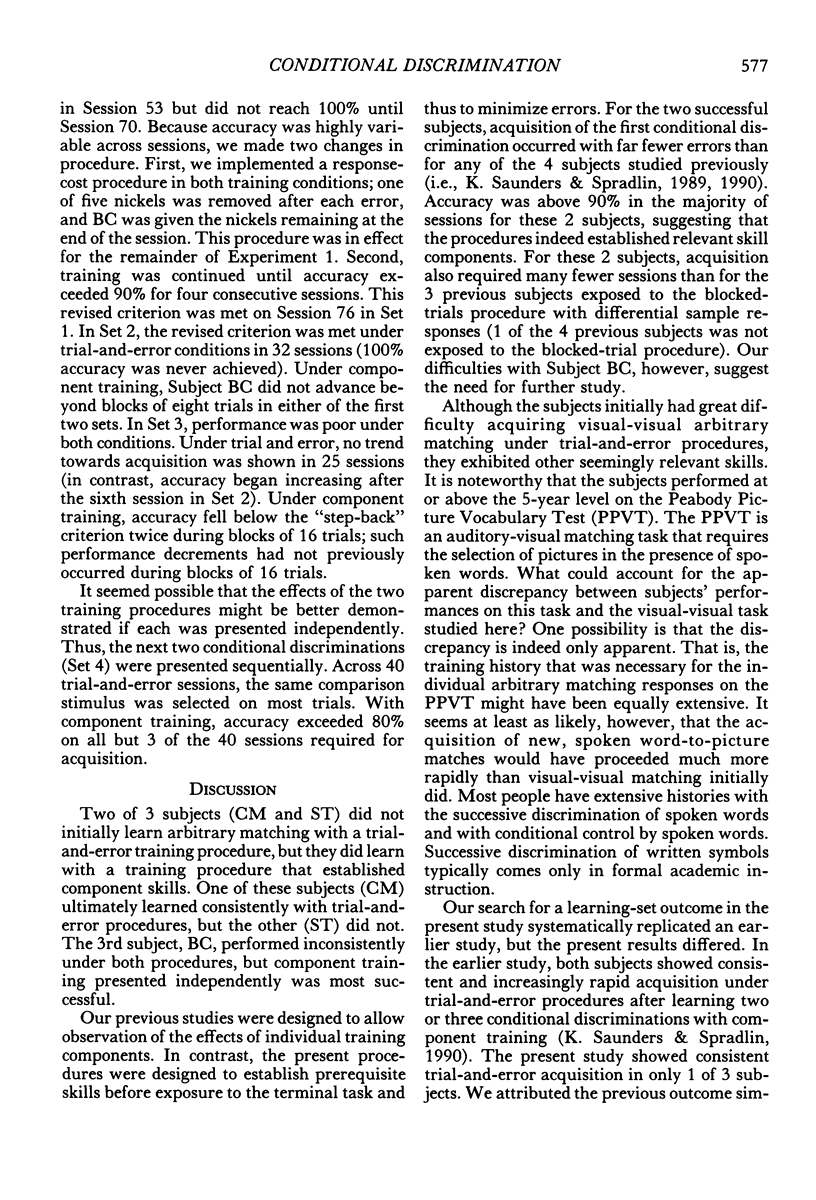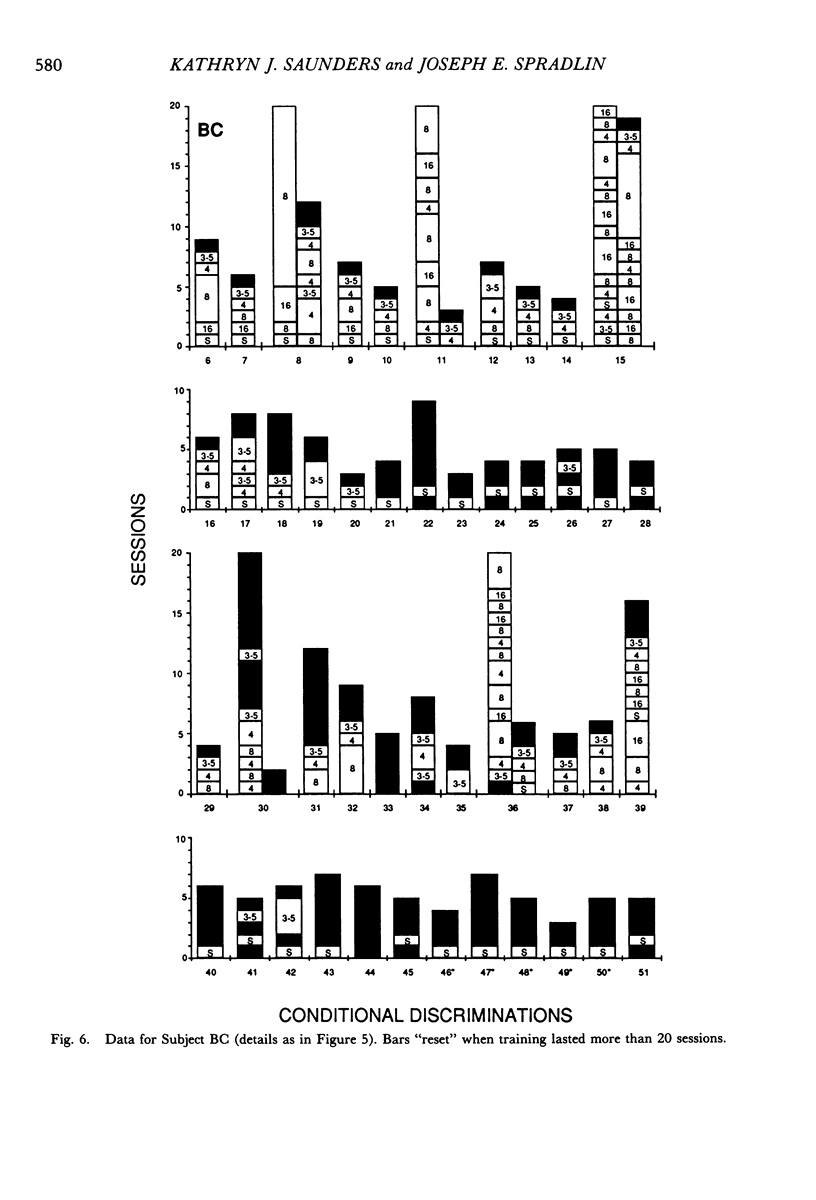Abstract
In Experiment 1, 3 subjects with retardation were exposed to two visual-visual arbitrary matching-to-sample problems each day. One conditional discrimination was presented under trial-and-error conditions, and the other was presented under a component training procedure. The latter began by establishing the comparison discrimination and its rapid reversal. The successive discrimination between the sample stimuli was established through differential naming. Then, sample naming was maintained in conditional discrimination sessions in which the same sample was presented in blocks of consecutive trials. Block size was decreased across sessions until sample presentation was randomized as in trial-and-error training (but with naming maintained). Two subjects initially learned only with component training. The performance of the 3rd subject was inconsistent across conditional discriminations. One of the successful subjects ultimately learned rapidly and consistently with trial-and-error procedures. Experiment 2 sought to demonstrate learning set in the other 2 subjects. Elements of the component training procedure were withdrawn over successive conditional discriminations. Ultimately, 1 subject nearly always learned under trial-and-error conditions, and the other learned under trial-and-error conditions combined with differential sample naming.
Full text
PDF














Selected References
These references are in PubMed. This may not be the complete list of references from this article.
- Carter D. E., Eckerman D. A. Symbolic matching by pigeons: rate of learning complex discriminations predicted from simple discriminations. Science. 1975 Feb 21;187(4177):662–664. doi: 10.1126/science.1114318. [DOI] [PubMed] [Google Scholar]
- Cohen L. R., Looney T. A., Brady J. H., Aucella A. F. Differential sample response schedules in the acquisition of conditional discriminations by pigeons. J Exp Anal Behav. 1976 Sep;26(2):301–314. doi: 10.1901/jeab.1976.26-301. [DOI] [PMC free article] [PubMed] [Google Scholar]
- HOLLAND J. G. Human vigilance: the rate of observing an instrument is controlled by the schedule of signal detections. Science. 1958 Jul 11;128(3315):61–67. doi: 10.1126/science.128.3315.61. [DOI] [PubMed] [Google Scholar]
- Herman L. M., Arbeit W. R. Stimulus control and auditory discrimination learning sets in the bottlenose dolphin. J Exp Anal Behav. 1973 May;19(3):379–394. doi: 10.1901/jeab.1973.19-379. [DOI] [PMC free article] [PubMed] [Google Scholar]
- McIlvane W. J., Dube W. V., Kledaras J. B., Iennaco F. M., Stoddard L. T. Teaching relational discrimination to individuals with mental retardation: some problems and possible solutions. Am J Ment Retard. 1990 Nov;95(3):283–296. [PubMed] [Google Scholar]
- McIlvane W. J., Kledaras J. B., Munson L. C., King K. A., de Rose J. C., Stoddard L. T. Controlling relations in conditional discrimination and matching by exclusion. J Exp Anal Behav. 1987 Sep;48(2):187–208. doi: 10.1901/jeab.1987.48-187. [DOI] [PMC free article] [PubMed] [Google Scholar]
- RIOPELLE A. J., COPELAN E. L. Discrimination reversal to a sign. J Exp Psychol. 1954 Aug;48(2):143–145. doi: 10.1037/h0061376. [DOI] [PubMed] [Google Scholar]
- Romski M. A., Sevcik R. A., Pate J. L. Establishment of symbolic communication in persons with severe retardation. J Speech Hear Disord. 1988 Feb;53(1):94–107. doi: 10.1044/jshd.5301.94. [DOI] [PubMed] [Google Scholar]
- Saunders K. J. Naming in conditional discrimination and stimulus equivalence. J Exp Anal Behav. 1989 May;51(3):379–384. doi: 10.1901/jeab.1989.51-379. [DOI] [PMC free article] [PubMed] [Google Scholar]
- Saunders K. J., Spradlin J. E. Conditional discrimination in mentally retarded adults: the development of generalized skills. J Exp Anal Behav. 1990 Nov;54(3):239–250. doi: 10.1901/jeab.1990.54-239. [DOI] [PMC free article] [PubMed] [Google Scholar]
- Saunders K. J., Spradlin J. E. Conditional discrimination in mentally retarded adults: the effect of training the component simple discriminations. J Exp Anal Behav. 1989 Jul;52(1):1–12. doi: 10.1901/jeab.1989.52-1. [DOI] [PMC free article] [PubMed] [Google Scholar]
- Saunders R. R., Wachter J., Spradlin J. E. Establishing auditory stimulus control over an eight-member equivalence class via conditional discrimination procedures. J Exp Anal Behav. 1988 Jan;49(1):95–115. doi: 10.1901/jeab.1988.49-95. [DOI] [PMC free article] [PubMed] [Google Scholar]
- Sidman M., Rauzin R., Lazar R., Cunningham S., Tailby W., Carrigan P. A search for symmetry in the conditional discriminations of rhesus monkeys, baboons, and children. J Exp Anal Behav. 1982 Jan;37(1):23–44. doi: 10.1901/jeab.1982.37-23. [DOI] [PMC free article] [PubMed] [Google Scholar]
- Sidman M., Stoddard L. T. The effectiveness of fading in programming a simultaneous form discrimination for retarded children. J Exp Anal Behav. 1967 Jan;10(1):3–15. doi: 10.1901/jeab.1967.10-3. [DOI] [PMC free article] [PubMed] [Google Scholar]
- Urcuioli P. J. On the role of differential sample behaviors in matching-to-sample. J Exp Psychol Anim Behav Process. 1985 Oct;11(4):502–519. doi: 10.1037//0097-7403.11.4.502. [DOI] [PubMed] [Google Scholar]
- Zygmont D. M., Lazar R. M., Dube W. V., McIlvane W. J. Teaching arbitrary matching via sample stimulus-control shaping to young children and mentally retarded individuals: a methodological note. J Exp Anal Behav. 1992 Jan;57(1):109–117. doi: 10.1901/jeab.1992.57-109. [DOI] [PMC free article] [PubMed] [Google Scholar]


